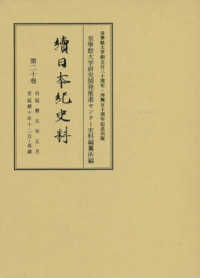- ホーム
- > 洋書
- > 英文書
- > Politics / International Relations
Full Description
This volume renews the study of corruption as 'embedded' in ongoing social relations. Instead of treating corruption as a universal phenomenon, A Comparative Historical Sociology of Corruption shows how corruption is often morally ambiguous and deeply intertwined with the social, political and economic struggles of particular groups in specific times and places. Ranging from Early Modernity to the present day, and spanning across the globe, the book focuses on three recurring aspects of corruption: emergence or the origins and struggles over whether something is corrupt; institutionalization or how different definitions of corruption predominate; and mobilization or the sociopolitical functions that different definitions of corruption serve in times of social change. The volume includes a wide variety of historical and contemporary studies to show that corruption is embedded in its context, providing a novel framework for readers to understand how and why corruption persists across time and place.
Contents
List of figures; List of contributors; Acknowledgements; 1. Introduction: a comparative historical sociology of corruption Marco Garrido, Marina Zaloznaya and Nicholas Hoover Wilson; Part I. Emergence: 2. The emergence of corruption in the Cambodian land market Marco Garrido; 3. The changing meaning of corruption and anti-corruption in Postwar China Juan Wang; 4. Corruption and the rule of difference in late-colonial Hong Kong Jack Jin Gary Lee and Kwai Hang Ng; 5. Governing difference: corruption, empire, and the founding of east India college Anurag Sinha; Part II. Institutionalization: 6. Brokers and bribery in urban India Sneha Annavarapu; 7. Can the same organization be corrupt and clean?: The changing contours of corruption under the metropolitan police of Buenos Aires Leslie MacColman; 8. The civic life of bribe-givers: bureaucratic corruption and political activity in Russia Marina Zaloznaya and William Reisinger; Part III. Mobilization: 9. Mobilization from above and below: the corruption narratives of Latin American free-market think tank elites and Colombian farmers Alex Diamond, and Tomás Gold; 10. Mobilization as promiscuous: unstable corruption allegations and the 'Negro Plot' of 1741 in New York City Nick Wilson; 11. The contingency of mobilization: the social contexts of operation Lava Jato in Brazil Fernando Forattini; 12. The structure of the anti-corruption field Byron Villacis; 13. Conclusion: deep analogies across different configurations of corruption Nicholas Hoover Wilson, Marco Garrido and Marina Zaloznaya.








